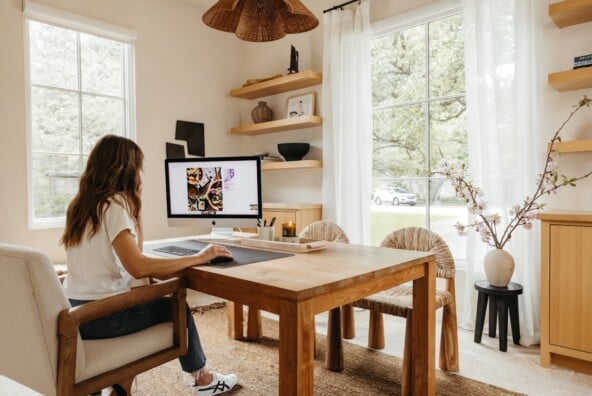Fist bumps instead of handshakes. Knuckles are the new fingers. And watch the gas pump. Those are some of the recommendations from Dr. James Robb, a former professor of pathology at the University of California San Diego who began studying the coronavirus more than 30 years ago. With the growing concerns regarding the worldwide outbreak of the coronavirus (COVID-19), we are taking Dr. Robb’s advice very seriously and doing a few things to prep our homes and our families to try and stay healthy and minimize the risk of catching the influenza strain that still remains a fearful mystery. See below for a letter that Dr. Robb sent out to his fellow colleagues with precautions everyone should be taking — we found his advice to be positive, helpful and great reminders to all.
In a nutshell, the basic guidance to the general public remains the same: If you’re retirement age or older, or if you have underlying health problems, avoid crowds and anyone with cold or flu symptoms. Otherwise, wash your hands well and often, and don’t panic.
Learn more about the symptoms associated with COVID-19 here.

Excerpted from a letter by Dr. James Rob, MD:
Dear Colleagues,
As some of you may recall, when I was a professor of pathology at the University of California San Diego, I was one of the first molecular virologists in the world to work on coronaviruses (the 1970s). I was the first to demonstrate the number of genes the virus contained. Since then, I have kept up with the coronavirus field and its multiple clinical transfers into the human population (e.g., SARS, MERS), from different animal sources.
The current projections for its expansion in the US are only probable, due to continued insufficient worldwide data, but it is most likely to be widespread in the US by mid to late March and April.
Here is what I have done and the precautions that I will continue to take:
1) NO HANDSHAKING! Use a fist bump, slight bow, elbow bump, etc.
2) Use ONLY your knuckle to touch light switches. elevator buttons, etc. Lift the gasoline dispenser with a paper towel or use a disposable glove.
3) Open doors with your closed fist or hip – do not grasp the handle with your hand, unless there is no other way to open the door. Especially important on bathroom and post office/commercial doors.
4) Use disinfectant wipes at the stores when they are available, including wiping the handle and child seat in grocery carts.
5) Wash your hands with soap for 10-20 seconds and/or use a greater than 60% alcohol-based hand sanitizer whenever you return home from ANY activity that involves locations where other people have been.
6) Keep a bottle of sanitizer available at each of your home’s entrances. AND in your car for use after getting gas or touching other contaminated objects when you can’t immediately wash your hands.
7) If possible, cough or sneeze into a disposable tissue and discard. Use your elbow only if you have to. The clothing on your elbow will contain infectious virus that can be passed on for up to a week or more!

Here’s what I have stocked in preparation for the pandemic spread to the US:
1) Latex or nitrile latex disposable gloves for use when going shopping, using the gasoline pump, and all other outside activity when you come in contact with contaminated areas.
Note: This virus is spread in large droplets by coughing and sneezing. This means that the air will not infect you! BUT all the surfaces where these droplets land are infectious for about a week on average – everything that is associated with infected people will be contaminated and potentially infectious. The virus is on surfaces and you will not be infected unless your unprotected face is directly coughed or sneezed upon.
This virus only has cell receptors for lung cells (it only infects your lungs) The only way for the virus to infect you is through your nose or mouth via your hands or an infected cough or sneeze onto or into your nose or mouth.
2) Stock up now with disposable surgical masks and use them to prevent you from touching your nose and/or mouth (We touch our nose/mouth 90X/day without knowing it!). This is the only way this virus can infect you – it is lung-specific. The mask will not prevent the virus in a direct sneeze from getting into your nose or mouth – it is only to keep you from touching your nose or mouth.
3) Stock up now with hand sanitizers and latex/nitrile gloves (get the appropriate sizes for your family). The hand sanitizers must be alcohol-based and greater than 60% alcohol to be effective.
4) Stock up now with zinc lozenges. These lozenges have been proven to be effective in blocking coronavirus (and most other viruses) from multiplying in your throat and nasopharynx. Use as directed several times each day when you begin to feel ANY “cold-like” symptoms beginning. It is best to lie down and let the lozenge dissolve in the back of your throat and nasopharynx. Cold-Eeze lozenges is one brand available, but there are other brands available.
I, as many others do, hope that this pandemic will be reasonably contained, BUT I personally do not think it will be. Humans have never seen this (edited: animal)-associated virus before and have no internal defense against it.
Tremendous worldwide efforts are being made to understand the molecular and clinical virology of this virus. Unbelievable molecular knowledge about the genomics, structure, and virulence of this virus has already been achieved. BUT, there will be NO drugs or vaccines available this year to protect us or limit the infection within us. Only symptomatic support is available.
I hope these personal thoughts will be helpful during this potentially catastrophic pandemic. You are welcome to share.
Good luck to all of us!
Dr. James Robb
Dr. James Robb received his MD degree at the University of Colorado and took a residency in pathology, as well as training in molecular biology, at Yale University. He has worked for the National Institutes of Health, and been a consulting pathologist at the National Cancer Institute. He is board certified in anatomic pathology, clinical pathology, cytopathology, and dermatopathology.





